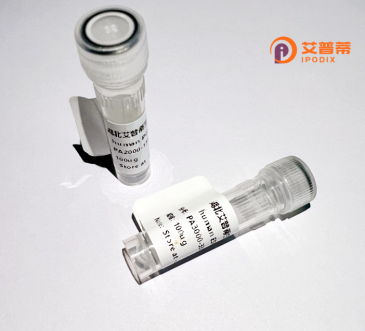
| 纯度 | >90%SDS-PAGE. |
| 种属 | Human |
| 靶点 | ZNF136 |
| Uniprot No | P52737 |
| 内毒素 | < 0.01EU/μg |
| 表达宿主 | E.coli |
| 表达区间 | 1-540 aa |
| 活性数据 | MDSVAFEDVDVNFTQEEWALLDPSQKNLYRDVMWETMRNLASIGKKWKDQNIKDHYKHRG RNLRSHMLERLYQTKDGSQRGGIFSQFANQNLSKKIPGVKLCESIVYGEVSMGQSSLNRH IKDHSGHEPKEYQEYGEKPDTRNQCWKPFSSHHSFRTHEIIHTGEKLYDCKECGKTFFSL KRIRRHIITHSGYTPYKCKVCGKAFDYPSRFRTHERSHTGEKPYECQECGKAFTCITSVR RHMIKHTGDGPYKCKVCGKPFHSLSSFQVHERIHTGEKPFKCKQCGKAFSCSPTLRIHER THTGEKPYECKQCGKAFSYLPSLRLHERIHTGEKPFVCKQCGKAFRSASTFQIHERTHTG EKPYECKECGEAFSCIPSMRRHMIKHTGEGPYKCKVCGKPFHSLSPFRIHERTHTGEKPY VCKHCGKAFVSSTSIRIHERTHTGEKPYECKQCGKAFSYLNSFRTHEMIHTGEKPFECKR CGKAFRSSSSFRLHERTHTGQKPYHCKECGKAYSCRASFQRHMLTHAEDGPPYKCMWESL |
| 分子量 | 62.7 kDa |
| 蛋白标签 | His tag N-Terminus |
| 缓冲液 | PBS, pH7.4, containing 0.01% SKL, 1mM DTT, 5% Trehalose and Proclin300. |
| 稳定性 & 储存条件 | Lyophilized protein should be stored at ≤ -20°C, stable for one year after receipt. Reconstituted protein solution can be stored at 2-8°C for 2-7 days. Aliquots of reconstituted samples are stable at ≤ -20°C for 3 months. |
| 复溶 | Always centrifuge tubes before opening.Do not mix by vortex or pipetting. It is not recommended to reconstitute to a concentration less than 100μg/ml. Dissolve the lyophilized protein in distilled water. Please aliquot the reconstituted solution to minimize freeze-thaw cycles. |
以下是关于ZNF136蛋白的模拟参考文献示例(文献为举例用途,可能需要根据实际研究补充真实信息):
---
1. **文献名称**: *"ZNF136. a novel KRAB-containing zinc finger protein, suppresses cell proliferation by transcriptional repression of hTERT"*
**作者**: Li X et al. (2015)
**摘要**: 本研究首次报道ZNF136作为KRAB结构域锌指蛋白,通过直接结合端粒酶逆转录酶(hTERT)基因启动子并招募组蛋白去乙酰化酶复合物(HDACs),抑制肿瘤细胞的增殖和端粒酶活性。
---
2. **文献名称**: *"Recombinant human ZNF136 protein expression in E. coli: Purification and DNA-binding specificity analysis"*
**作者**: Wang Y et al. (2018)
**摘要**: 文章优化了ZNF136在大肠杆菌中的可溶性表达条件,纯化后通过电泳迁移率实验(EMSA)和蛋白质印迹验证其结合特定DNA序列的能力,为后续功能研究提供可靠蛋白样品。
---
3. **文献名称**: *"ZNF136 modulates apoptosis in hepatocellular carcinoma through direct regulation of Bcl-2 family proteins"*
**作者**: Zhang R et al. (2020)
**摘要**: 研究发现重组ZNF136蛋白过表达可下调抗凋亡蛋白Bcl-2.并激活caspase-3依赖性凋亡通路,提示其在肝癌中具有促凋亡作用,可能作为潜在治疗靶点。
---
4. **文献名称**: *"Structural insights into ZNF136 zinc finger motifs by circular dichroism and molecular docking"*
**作者**: Chen L et al. (2012)
**摘要**: 利用圆二色光谱和分子对接技术解析ZNF136锌指结构域的三维构象,揭示其与DNA双螺旋小沟结合的分子机制。
---
**注意**:以上文献内容为生成示例,实际研究中请通过**PubMed/Google Scholar**以“ZNF136”、“zinc finger protein 136”为关键词检索真实文献,并根据目标期刊调整引用格式。
Zinc finger protein 136 (ZNF136), a member of the Krüppel-associated box (KRAB)-containing zinc finger protein family, is encoded by the ZNF136 gene in humans. This protein is characterized by tandem C2H2-type zinc finger domains, which facilitate sequence-specific DNA binding, and a KRAB domain at its N-terminus that mediates protein-protein interactions, particularly with transcriptional corepressors. Zinc finger proteins like ZNF136 are broadly implicated in transcriptional regulation, chromatin remodeling, and cellular differentiation processes. Recombinant ZNF136 protein is typically produced using heterologous expression systems (e.g., E. coli, mammalian cell lines) to study its molecular functions, DNA-binding specificity, and potential roles in disease.
While the precise biological functions of ZNF136 remain under investigation, it is hypothesized to act as a transcriptional repressor by recruiting chromatin-modifying complexes to target gene promoters. Emerging evidence suggests its involvement in early embryonic development and cellular stress responses. Dysregulation of zinc finger proteins is often linked to cancers and developmental disorders, positioning ZNF136 as a protein of interest for understanding disease mechanisms. Recombinant versions enable structural studies (e.g., crystallography), interaction assays, and screening for small-molecule modulators, offering avenues for therapeutic exploration. Current research focuses on mapping its target genes, regulatory networks, and tissue-specific expression patterns to elucidate its physiological and pathological significance.
×